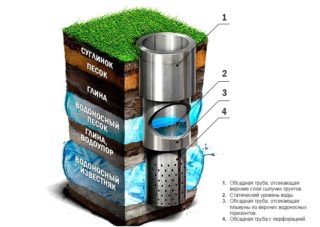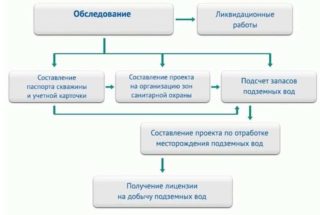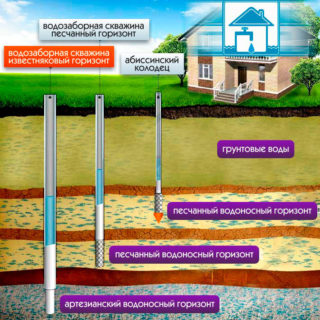Water intake structures from underground sources are built in country houses, farm lands to establish an autonomous water supply network. Water wells do not belong to the group of hydraulic structures of the first lift. This structure is equipped with special pumping stations or a water pump for lifting groundwater to the surface.
Purpose and device of a water well

A water well is a special hydraulic structure designed for the intake of groundwater from the water-bearing layer of the soil. It is a pipe with a pump, the latter is necessary to maintain the pressure of the water column.
The water intake includes the following parts:
- Column or casing - sinks into the bowels of the earth, it can be characterized by a different diameter, length and material of manufacture. The most demanded pipes are polyethylene, concrete and steel.
- The filter is designed to cleanse the liquid from impurities from the soil.
- Water pump. There are several types of equipment and different modifications. Depending on the depth of the well, its diameter, a submersible or surface pump equipped with an electric motor is chosen. It is necessary for transporting the water column from the well to the water tap in the house.
- The wellbore is located inside the casing, through which water rises to the surface.
Groundwater can be at different depths, as a rule, this parameter ranges from 5-10 meters to 80 or more.
Depending on this indicator, water wells are divided into several types.
Types of water intake facilities
- The Abyssinian well has a depth ranging from 10 to 12 meters. These are the smallest indicators among all types of sources. For the arrangement, the barrel and casing are not used, a "needle" is enough - pipes with a diameter of 70 mm. If the soil layers are soft, there is no need for drilling, it is enough just to drive it into the ground. The process cannot be called time-consuming, it does not take much time, effort and finances. A perceptible disadvantage of such a source is the dubious quality of the water. Sometimes it is completely undrinkable. The debit is 0.5 cubic meters / hour, which is enough for a country house and garden house with non-permanent residence. The service life reaches 10 years, but more often the resource is exhausted after 3-5 years.
- Well on the sand. The depth of groundwater can reach 30 meters. Consists of a string or casing with a diameter of up to 130 mm. Drilling such a source requires special equipment and tools. Drilling can take more than one day, and considerable investments are also required. The productivity or debit of the source reaches 1.5 cubic meters / hour. The approximate operating life is 15 years.
- An artesian well is characterized by a great depth, which reaches 100 meters or more. Water from such a source is considered to be of the highest quality and cleanest, since groundwater no longer penetrates into it. The diameter of the casing or pipe reaches 160 mm. The initial performance indicators are 3 cubic meters / hour, so the distribution of water can simultaneously occur to several taps.The service life is more than 50 years, but the construction and arrangement of an artesian well requires large financial investments.
Each type of water well has its own characteristics, having familiarized with them, select the appropriate option for the personal plot.
Regulatory and technical documents and design stages

If the water intake structure is more than 50 meters deep, a license is required. These processes are handled by special commissions, which need to submit a full package of documents. As a rule, this is a laborious and time consuming process. Obtaining a certificate can take from six months to a year.
To obtain a license, proceed as follows:
- At the initial stage, a permit is issued to carry out work in order to ensure an autonomous water supply system. It is important to strictly follow the instructions specified in the document.
- Compulsory registration is required for ongoing drilling and well completion work.
- After familiarization with the stock material, the homeowner receives the terms of reference for the work.
- At the next stage, the design work for the search and study of the contents of the subsoil is drawn up.
- The project is preliminarily undergoing geological expertise.
- The project documentation is coordinated with the relevant authorities.
- They begin to perform the work described in the project.
- Experimental filtration surveys are carried out by foremen.
- Analyze water reserves and quality. Additionally, studies for radioactivity are being carried out.
- Information about the well is collected: depth and diameter, dynamic and static water level, structure debit. A report on the assessment of the aquifer reserves is prepared.
- A project of sanitary protection zones is being prepared.
- Registration of a sanitary and epidemiological conclusion.
After completing all the above documentation and carrying out the work, you can obtain a license and register the source.
Sanitary protection zone of the water supply source

Each water intake structure has three zones of sanitary protection zones. Thanks to them, it is possible to prevent the ingress of various kinds of contaminants and pathogens into the water. Features and characteristics of each of the belts:
- The first security zone has a radius of 15-60 meters. This circle must be surrounded by a fence. The construction of facilities is prohibited here, with the exception of those that are needed for the operation of a water well.
- The main task of the second security zone is to protect well water from bacteriological pollution. It is forbidden to build objects that may carry a potential threat here. We are talking about all local treatment facilities, for example, septic tanks, manure and cesspools. The radius of the ring is calculated using a special formula and depends on several factors - the depth of the groundwater and the characteristics of the area.
- The third protection zone is designed to protect the source from chemical pollution. Within the radius of this ring it is strictly forbidden to build storage facilities for fertilizers, warehouses for pesticides and fuels and lubricants. The radius is also calculated using a special formula.
At the design, construction and completion stage of a well, it is better to give preference to construction companies with experience in this area.









